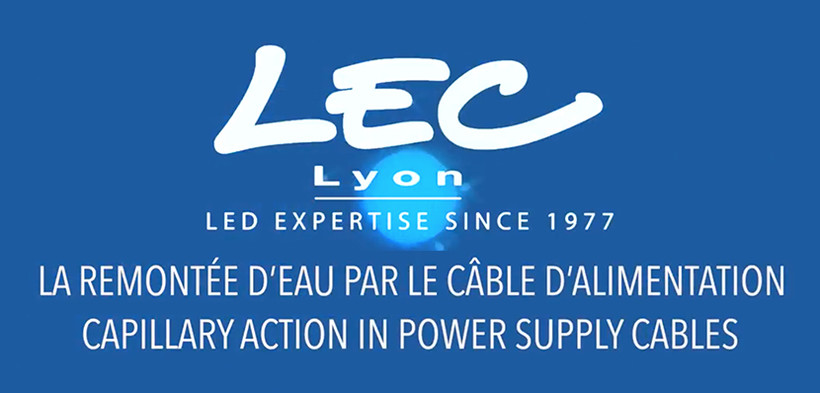Waterproof LED Lights: Preventing Capillary Action in Power Supply Cables
Download the PDFWaterproofing LED lights is not enough, their entire electrical installation needs to be sealed. A lamp may be certified according to IP67 or IP68, but when it comes to the installation and connections, things are not that simple.
Ingress of water or vapor into LED lights causes damages and manifests itself by condensation or droplets of water beneath the face-plate when the product is switched on, by a change in photometry, and then by a short circuit and corrosion of electric circuits, which will destroy the light completely.
To provide good water resistance in LED lights it is therefore essential that all of the following parts be perfectly waterproof: body, junction body to face-plate, power supply cable and command input, connection of cable to network installation.
LED and water tightness: the power supply cable
There are many points of possible water ingress and capillary action and it should be noted to not miss any of them as to guarantee the durability of the LED lights. The following points should be checked: face-plate, external control units and cable gland.
In addition, there is one other way of possible water ingress that is often overlooked: the power supply cable. We are not referring to the lining of the cable, for which an AD8 type rating will guarantee a veritable barrier to water, but to the cable end.
How can the water move up the cable, defying gravity, capillarity, loops and possible lengths? To explain this, we need to introduce you to the concept of the pumping effect.
The pumping effect and capillary action in cables
A powered spot light heats up and the air inside its case expands. If there is even the smallest leak, the air is ejected due to the pressure increasing measurably by 0.15 atmosphere (the difference in internal pressure of the product sealed at 20°C and the same product at 65°C).
This overpressure is more than enough to eject air via the end of the power supply cable.
When we now turn off the light its temperature decreases. According to the ideal gas law the air now contracts, which will cause suction via the end of the cable. If the cable end is in contact with water, the water vapor will be sucked in. If it is surrounded by humid atmosphere, water vapor will be sucked in and condensate inside the light. If 15 % of the air inside the cable was ejected during the rise in temperature, this is the equivalent of the volume that will be sucked in when the temperature falls again.
The video below clearly shows the pumping effect.
Waterproof LED lights: the interconnect and protection ratings
Of course, power supply cable ends rarely soak in water. But in the long run the interconnect needs to be perfectly waterproof and protected even from water vapor.
As a matter of fact, let’s assume that when 15 % of the air volume in the light is sucked in, the gaseous equivalent of only one mini droplet passes through. Once it is inside the product, the gaseous molecules of water dissolved in the air will condense on the colder inner lining.
Subsequently, when the LED light heats up we can be sure that the water will not leave the cable again as a liquid, but in the form of dry air. In this way, due to the pumping effect more and more water will accumulate inside the product until a saturation in humidity is reached. Big drops will appear not only on the cold surfaces: the internal electronics will also begin to deteriorate.
Under these conditions it becomes evident that power supply cable ends need to be treated with the same level of attention as the LED light itself, while choosing the right IP code. As indicated by the standard IEC 60529, this protection rating classifies the degree of protection of a product against intrusion or ingress.
Avoid false economy when it comes to this! For waterproof LED lights, it is of crucial importance to choose an interconnector with a minimum IP of 67. Failing to do so could introduce a weak link in the chain of waterproof parts and result in the whole installation losing its IP
LEC’s solution: a blocking system for capillary action
To guarantee waterproof LED products should the installation not comply with the sufficient IP degree, LEC has introduced a proprietary process of blocking capillary action in cables.
This unique contact system guarantees:
- perfect water tightness inside the light
- increased longevity of installations
- optimum cabling, embedded or outdoors
Even though the standard NF-C 17200d only recommends the use of waterproof sheaths, this process goes a step further: it blocks the flow of gas or liquid between the sheath and the wires of the cable, but also between the strands of multi-conductor wires with a flexible core.
Not only can water no longer enter the LED light, but also the pumping effect that could occur at the interconnection is blocked. This reduces the stress of low pressure on the junction boxes.
Waterproof LED lights, installed according to the state-of-the-art technology
Of course, this additional safety blocking of capillary action does not relieve you of laying cables following the rules of state-of-the-art technology. In fact, if the LED light is preserved and suction prevented, it is still not protected from a leak in the junction boxes, which will lead to oxidation or corrosion in the terminal strip causing disturbances in the power supply and the functional capability of the lights.
At LEC, we recommend installations that minimize the need for maintenance work. In this way, the combination of blocking capillary action in spot lights and suitable connector accessories will guarantee an LED installation that lasts. No need to return to the site, except if you want to enjoy the lighting!
Do you have an outdoor lighting project with precise requirements for water resistance? Have a LEC expert contact you!
-
Download the PDF
- Published on 18 January 2018
- Categories: Lighting techniques - Solutions by LEC
- Tags : capillary action - LED luminaire - power supply cable - pumping effect - waterproof LED

